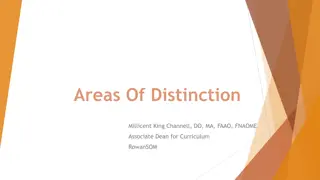Effective Strategies for Engaging Students in Blackboard Discussions
Explore effective strategies for engaging students in Blackboard discussions through insightful tips and practical examples. Learn how to start strong with communication, manage discussions, and evaluate participation using rubrics. Enhance student engagement and interaction in online learning environments.
Download Presentation

Please find below an Image/Link to download the presentation.
The content on the website is provided AS IS for your information and personal use only. It may not be sold, licensed, or shared on other websites without obtaining consent from the author.If you encounter any issues during the download, it is possible that the publisher has removed the file from their server.
You are allowed to download the files provided on this website for personal or commercial use, subject to the condition that they are used lawfully. All files are the property of their respective owners.
The content on the website is provided AS IS for your information and personal use only. It may not be sold, licensed, or shared on other websites without obtaining consent from the author.
E N D
Presentation Transcript
Engaging Students in Blackboard Discussions
Engaging Students in Blackboard Discussions Microphone Muted Chat Panel Today s Presenters: LeAnn Krosnick, Sr. Instructional Designer Sarah Rutland, QA Manager/Sr. Instructional Designer
Engaging Students in Blackboard Discussions 3 X 3 Discussion Tips 6 Effective Discussion Strategies 7 Tips for Managing Discussions Content used by permission from Dr. Lisa Kidder & Mark Cooper presentation: Breaking the Humdrum of Post Once & Reply to 2 , Idaho State University
Starting Strong with Communication 3 x 3 Discussion Tips
If this looks familiar I like riding bikes! I agree, I like riding bikes too. I especially liked the part where you said you liked riding bikes!
Or this 2 + 2 = 4 Wow, I totally agree. I like how you added the 2 s together and got 4, very insightful.
3 x 3 General Tips May Help Prompt Post / Reply Grading No single answer questions. Clear/ specific instructions. 1. 1. Grading reflects what you want to get out of it. Use open-ended questions. Clear/ specific expectations. 2. 2. Don t make grading difficult. Question as problem statement. Set rules for netiquette. 3. 3. Provide specific/ descriptive grading criteria.
Rubric Example Criteria Meets/Exceeds Requirements 10pts Participant FULLY ADDRESSES the discussion topic question, RELATES TO CURRENT OR PAST COURSE MATERIALS and STIMULATES FURTHER DISCUSSION. Meets Most Requirements 5 pts Participant may have fully addressed discussion topic question, but may not relate the topic to course materials and/or stimulate further discussion. Needs Improvement 0 pts Original post in response to the question posted by the instructor Participant did not fully address discussion topic question or relate it to course materials. Post length is less than a paragraph and may have contained grammatical or stylistic error. Responses to other students Participant posted TWO RESPONSES to classmates and RESPONSES STIMULATED FURTHER DISCUSSION as well as described whether the participant AGREED OR DISAGREED wither the post and why. Participant only posted one response to another classmate and/or did not post response(s) that stimulated further discussion. Participant did not post any replies to other participants or posted only short statements that did not stimulate the discussion.
Starting Strong with Communication 6 Effective Discussion Strategies
Starting Strong with Communication 1. Case Study
Case Study Description Requires learners to read a real-life case and answer, discuss, or argue open-ended questions or develop solutions with accompanying data to analyze.
Case Study Purpose A major advantage of teaching with case studies is that the learners actively engage in problem-solving and analysis. This develops skills in problem-solving analytical skills (quantitative and/or qualitative) decision making coping with ambiguities
Case Study Usage Case studies work well in settings where there are real- world situations to explore and apply learning. Case studies work well in many academic disciplines. Case studies can be done individually or in small groups so that the learners can brainstorm solutions and share the workload.
Case Study Example Carefully read the Social Work Case Study and answer the questions in the discussion forum. Refer to Social Work: Policy and Legal Frameworks. Discussion Questions: What are you thinking? What is worrying you? What is the first thing you are going to do or say? How do you ensure that Vicky is kept safe and still respect her wishes and feelings? Do you have any right to intervene? Where/from whom could you seek help? What next?
Starting Strong with Communication 2. Debate
Debate Description A debate online can be set up between two or more groups or teams to argue a subject that is open for discussion.
Debate Purpose Debates work well to practice skills in critical thinking and is very effective in actively engaging students. Encourage student engagement and reasoning to support: Problem solving Current events Political action Changes within a discipline Leadership roles Interpretation of literature Theory Ethical considerations
Debate Usage Debate works well in many academic disciplines, such as Political Science Business/Economics Engineering Health/Medicine Law History Theology
Debate Example Topic: Is Affirmative Action necessary to create diversity in Higher Ed institutions? Arguments For: Equality and opportunity Overcomes prejudice Changes negative perceptions of university life Increases the number of minorities Arguments Against: Achievements should be earned, not given Affirmative action can create social tensions Affirmative action will not work Reduced appreciation for easy opportunities
Student Facilitation Description In a Student Facilitation discussion, the learners take on the role of instructor to provide feedback for posted responses.
Student Facilitation Purpose Student Facilitation discussions provide learners an opportunity to do a peer review. It can be set up so the learner/facilitator gets feedback from the instructor on their own responses before learners review their peers All learners practice the material, and by the end of the course, all learners have an opportunity to provide feedback to their peers.
Student Facilitation Usage Student Facilitation works well when learners need to solve problem sets for practice. Student Facilitation work work well in many academic disciplines, particularly: Math/Statistics Chemistry Computer Science
Student Facilitation Example Learner/Facilitator selects one of the designated problem sets and submits solution to the instructor ahead of time. All other students post their solutions, and the student facilitator provides feedback.
Challenge Questions Description Challenge Questions are mini case studies, presenting a short scenario and asking how would you handle this situation? Think of a drill exercise. The instructor sets up the forum by posing the question. Learners reply with a solution. Learners can also comment on the replies of their classmates.
Challenge Questions Purpose Challenge Question discussions present a scenario based on a situation learners could encounter in the real world and develops skills in: thinking on the fly problem-solving decision making rationalizing decisions
Challenge Questions Usage Challenge Questions are similar to case studies where this exercise explores and applies knowledge/skill to real-world situations, but in smaller/ micro situations. Challenge Question discussions work well in many academic disciplines, such as Law Health Medicine Social Work Psychology Engineering
Challenge Questions Example How would you communicate a new diagnosis of Autism to a parent? (Speech Pathology) Describe the difference between statistical significance and clinical significance. (Research Methods) What are the procedures to document a sexual harassment case? (Human Resources) How would you recognize the signs of a child of neglect? (Social Work)
In the News Description In the News discussions use examples from the media that present a statistic. Learners describe the limitations of taking statistics at face-value.
In the News Purpose In the News helps learners to: develop their critical thinking make real world connections see the authenticity of your content
In the News Usage In the News discussions focus on evaluating the credibility of statistical assertions. (This could be expanded beyond statistics.) In the News discussions work well in many disciplines where statistics (past or present) get reported to or from news media outlets, such as: Math Health/Medicine Political Science
In the News Example During your time in this course, pay attention to the statistical information presented in the media. Share a link to an article, or story. Describe the limitations of the presented statistics and/or what follow up questions you would want to ask to clarify the presented statistics.
Video Analysis Description Video Analysis is a forum that incorporates multimedia with an emphasis on identifying key features or aspects that were presented in the media.
Video Analysis Purpose Video Analysis discussions help learners to see examples presented in multimedia and then identify key features or apply what they have learned to the situation. It is best used when learners need to practice a task. Video Analysis (as with many discussion types) can be used as a formative assessment to check learner comprehension of ability to perform a task.
Video Analysis Usage Video Analysis work wells where learners need to recognize specific human behaviors such as: learning impairments speech anomalies teaching techniques Motor skills Video Analysis works in many academic disciplines where learners have to master tasks, such as: Health/Medicine Business Psychology Education
Video Analysis Example Watch all the videos. Select one and identify if the individual should be referred to another professional. Identify the times in the video where the characteristics are present that support your decision. For the videos you did not select review a classmate s response. Were there any additional characteristics you saw? Why do you agree or disagree with their interpretation?
7 Tips for Managing Discussions Content used by permission from Aaron Johnson, Excellent Online Teaching: Effective Strategies for a Successful Semester Online (2013).
4 Tips for Facilitating Discussions 1. Set a Goal to how many times you will post couple posts to the group 3. Timing is Important Post at time discussions are due Consider using summary posts post a follow-up question Establish expectations Stop when you hit your goal. 4. Be Clear on Purpose What is the purpose of discussion? Don t overwhelm 2. Be Brief in your responses Tell us more What is the learning outcome? What from the reading supports this? Imagine you are (a position opposite their own) what would be your two or three arguments against your current position? How would one s view of (the topic) affect the thought expressed in your post
3 Tips for Grading Discussions 1. 20/80 Approach to commenting on discussions (for lowest 20%) Only enter comments for 20% of students with the lowest score These are the ones who need direction Let them know what they are missing What they can do better next time If using rubric end comment with See the Discussion Rubric for grading expectations) 2. 20/80 for top 80% Create a generic message for the 80% doing satisfactory work Invite them to review rubric and contact you with any questions 3. For all Send class email I have graded all discussions with specific comments for those who most need improvement. Invite them to email if they desire more specific feedback.























